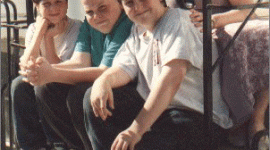Six Pillars to Treating ADD from Jason Alster
Interview with Jason Alster, author of "Being in Control" on alternative and natural treatments for ADHD.
Quite unexpectedly I received an email from Jason Alster.
It said this:
I am the author of the books BEING IN CONTROL: Natural Techniques for increasing your Potential and Creativity for Success in School and for Improving Concentration and Learning in Children with ADHD and Dyslexia and the book CREATIVE PAINTING FOR THE YOUNG ARTIST. I have been working with natural treatments of ADHD and test anxiety and dyslexia and have developed, over the last 15 years, a very powerful program to treat most cases of ADHD naturally and successfully. Whom may I speak to in your organization about workshops in the UK or distribution of these books and relay more information upon request? I do plan on being in the UK -London sometime in April and would be happy to meet up if possible. Sincerely, Jason Alster MSc, Center for Psychophysiology/Peak Performance and Learning Strategies, Zichron Yacov, Israel. Jason Alster
Intrigued by the man's confidence, I decided to meet him. We met at his hotel opposite the Natural History Museum. I was immediately struck by Jason's intensity and passion for his work.
I asked him to explain how he'd become involved in treating ADHD.
"I began treating children with ADD quite unexpectedly in 1991. I had been a biofeedback therapist as part of an anxiety clinic in a mental daycare setting in Tel Aviv, Israel. I had absolutely no experience in treating children but was doing quite well with adults suffering from stress disorders and teenagers who had test anxiety and social phobias. The biofeedback clinic had just opened and each type of patient was a new experience. With my medical-technological training in neuro-electro diagnostics and sleep/wake disorders, I was more into the neurological and psychophysiological disorders while a child psychologist working with me wanted to try biofeedback on ADD. Then he had said that there was no treatment for this poorly understood syndrome. The only remedy was Ritalin, although reports about EEG (electroencephalogram) biofeedback and Joel Lubar's research with neurofeedback were just coming out.
At first I used EMG (testing muscle tension). Then over time found that GSR (electrodermal resistance) was better and easier to use. At the time, there were no studies of GSR biofeedback for ADD. After starting to treat a handful of children with biofeedback the psychologist I was working with had to leave the unit and I had to take over his patients. All I knew then about ADD was from a television program showing a hyperactive child literally jump off the walls and I worried about what this child would do to my biofeedback equipment!
I had absolutely no knowledge of learning disorders either. I mention this lack of knowledge for a reason. I had to begin treating ADD without a prior predisposition to what was written in the literature. I had to see for myself what worked, and fast. "
How did you decide what would work?
"On my very first ADD patient I performed a regular biofeedback stress baseline for anxiety. That is, I hooked the child up to galvanic skin resistance (GSR) sensors, muscle and peripheral temperature monitors, but not EEG. I had to start to treat ADD with what I knew and that is how to treat stress and anxiety. I was lucky. My very first patient's baseline EMG (electromyogram or muscle activity potential good for measuring stress) showed that the more she sat quietly the EMG gained in amplitude. That is, sitting quietly was stressful for her. I tried relaxation training and she improved her baseline in just 6 sessions and began to do better both at home and in school. This was not supposed to happen. Biofeedback in ADD was supposed to be a stubborn neurological problem that takes 60 sessions to treat."
Your book, Being in Control, indicates that you have extended the range of tools you now use to treat youngsters with ADHD. It says that your methods are natural, integrative, and holistic and comply with recent theories in educational research. Does this mean you are against using ADHD stimulant medication?
"No, not at all, stimulant medication for ADHD has its place for some youngsters and their parents. I wanted to find an effective, alternative method to offer those young people and especially parents who wouldn't, or didn't want to, use medication to treat ADHD. At least these children wouldn't be left untreated. I then found that my method worked so well with the many children in our trials that it could be a viable alternative to medication and should perhaps be tried as a first line treatment.
In my readings at the time, a number of avenues were being pursued in the treatment of ADD. Some of these ADD treatments were nutritional, sensory integration, guided imagery, art therapy, natural meditation, yoga, Bach flower remedies, homeopathy, chiropractic, and the use of aromatic oils. In biofeedback, animated computer games were being introduced. I decided I could use each method and observe its effectiveness. I could develop an integrated and holistic approach. I could match the method to each child individually. One of the first things that I found that can cause the GSR to become stable in ADD children and adults is holding a soft or smooth stone in your hand. Who would ever expect that this piece of nature could compete with Ritalin? But it does. I got this idea from the worry stones and beads of the Middle East." (end of interview)
Jason Alster is keen to not only promote his books Being In Control and Creative Painting for the Young Artist, but he also wants to run workshops to train facilitators in his methods. He feels that any practitioner with an existing qualification, such as teachers, social workers, psychologists, classroom assistants and so forth could easily learn, employ and devolve his methods and these would be beneficial to any children that were struggling with ADHD, Dyslexia and other learning disorders.
His books are not big learned volumes full of highly technical information, but encapsulate the thinking and methods that he uses. They are small, soft backed books written and illustrated in such a way as to be immediately accessible to the children who will use them and easy for parents to facilitate the steps required.
Jason Alster convinced me that his 6 pillars approach - Animated Biofeedback, Sensory integration, Emotional intelligence, Accelerated learning, Creativity and Natural nutrition could add to the armory of ADHD treatments for all affected children, on its own for some and in conjunction with ADHD medication and psychological interventions for others.
APA Reference
Staff, H.
(2008, December 21). Six Pillars to Treating ADD from Jason Alster, HealthyPlace. Retrieved
on 2024, April 18 from https://www.healthyplace.com/adhd/articles/six-pillars-to-treating-add-from-jason-alster

